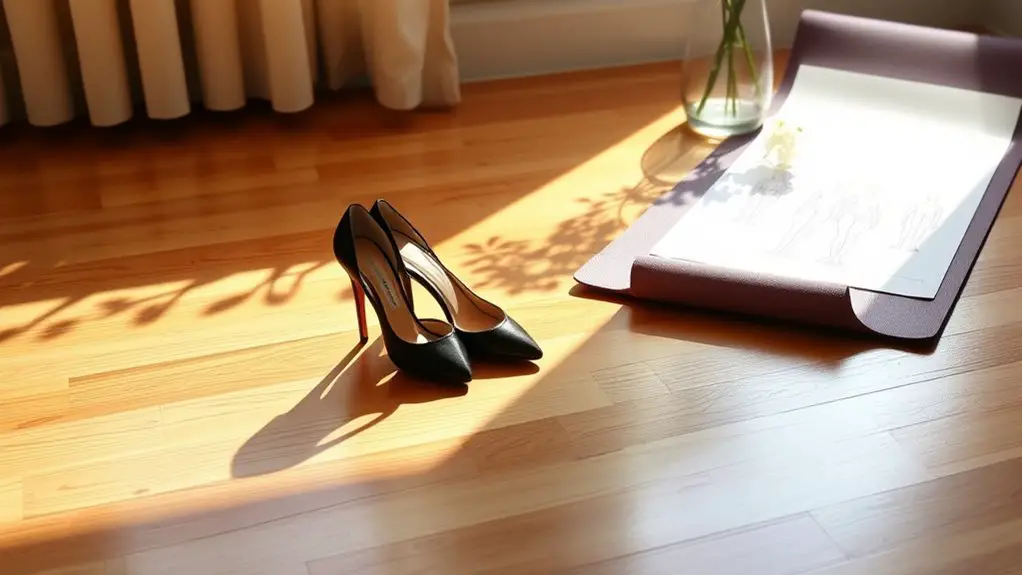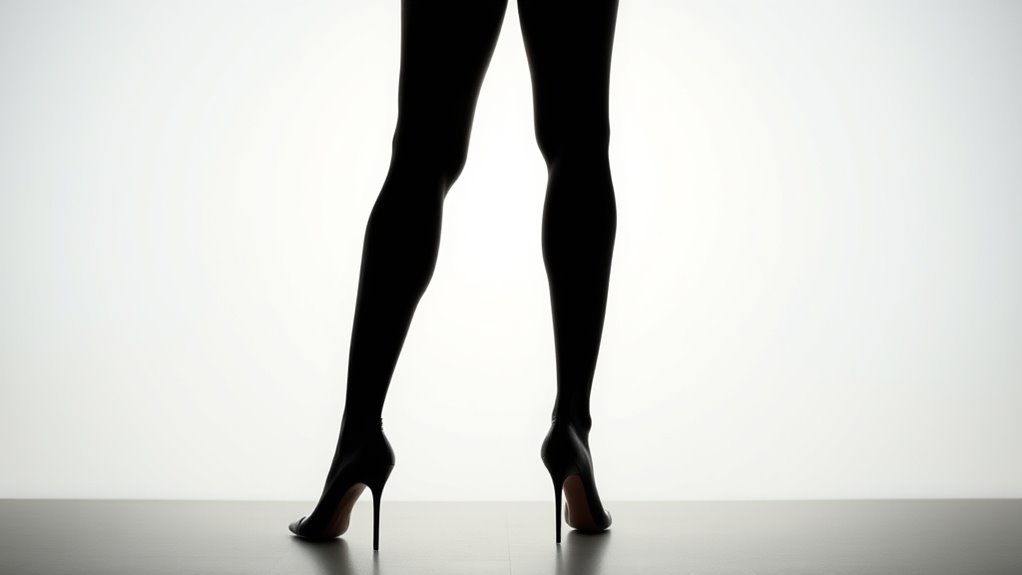Wearing high heels markedly impacts your posture and spine. The elevated heel design shifts your weight to the forefoot, causing an anterior pelvic tilt that disrupts spinal alignment. This alteration increases lumbar curvature, leading to chronic back pain and excessive strain on your knees and hips. Additionally, the rigid structure restricts natural foot movement, contributing to muscle imbalances and discomfort. Understanding these effects is vital for making informed footwear choices that promote better spinal health and overall well-being.
The Anatomy of High Heels

When you consider the design of high heels, it becomes clear that their structure greatly influences posture and biomechanics. The heel design, typically elevated, shifts weight from the heel to the forefoot, altering the natural alignment of the foot anatomy. This elevated position compresses the metatarsal bones and can lead to increased pressure on the ball of the foot, causing discomfort and potential long-term issues.
Moreover, the arch of the shoe often accentuates the foot’s natural curve, which alters the distribution of forces throughout the body. As your foot is forced into a pointed shape, the Achilles tendon may shorten, affecting gait and stability. The overall construction of high heels doesn’t just impact your feet; it also extends its effects up the kinetic chain, influencing your knees, hips, and spine. Understanding these anatomical implications is vital for evaluating the effects of high heels on your overall posture.
How High Heels Alter Your Natural Posture
Wearing high heels greatly shifts your center of gravity, forcing your body to adapt to an unnatural stance. This alteration impacts pelvic alignment and increases the curvature in your lumbar spine, which can lead to discomfort and postural issues. Understanding these changes is essential for maintaining overall spinal health while wearing heels.
Center of Gravity Shift
High heels greatly alter your center of gravity, which can have profound effects on your natural posture. This gravity shift forces your body to compensate, often leading to balance disruption that affects your overall stability.
- Your hips may thrust forward, altering the alignment of your spine.
- Your knees can lock in an unnatural position, increasing strain on joints.
- Your shoulders may roll back, creating tension in the upper back.
These adjustments can lead to discomfort and long-term postural issues. When you’re wearing high heels, your body’s equilibrium is compromised, prompting compensatory mechanisms that aren’t ideal for your musculoskeletal health. Understanding these changes is essential to recognizing how high heels impact your posture and spine.
Altered Pelvic Alignment
The shift in your center of gravity due to high heels leads to significant changes in pelvic alignment. When you wear high heels, your pelvis often adopts an anterior pelvic tilt, which alters the natural curvature of your spine. This tilt can create undue stress on your lumbar region, compromising lumbar support. As your pelvis tilts forward, your lower back may become overly extended, resulting in discomfort and potential long-term issues. The altered pelvic alignment can also affect your overall posture, leading to muscle imbalances and strain. It’s crucial to recognize these changes, as they can impact not just your comfort but also your overall spinal health. By being aware of this shift, you can make informed choices about footwear and posture.
Increased Lumbar Curve
When you don heels, your body compensates for the elevation by increasing the lumbar curve, which can disrupt your natural spinal alignment. This alteration often leads to discomfort and long-term issues if proper lumbar support isn’t utilized. The higher the heel height, the more exaggerated this curve becomes, causing your pelvis to tilt forward and your lower back to arch excessively.
- A pronounced sway in your lower back
- Strained muscles in your lower back and hips
- Increased pressure on spinal discs
These changes can result in chronic pain and may even affect your gait. It’s crucial to reflect on the implications of heel height on your posture to maintain spinal health and overall well-being.
The Impact on Spine Alignment
Although many may view high heels as a fashion statement, their impact on spine alignment is significant and should not be overlooked. Wearing high heels can lead to spine compression and various alignment issues. When you elevate your heels, your center of gravity shifts, which forces your spine into an unnatural position. This misalignment can result in long-term consequences for spinal health.
| Effect on Spine | Description | Potential Consequences |
|---|---|---|
| Increased Curvature | High heels exaggerate the lumbar curve | Chronic back pain |
| Altered Posture | Forward tilt of pelvis | Poor spinal alignment |
| Spinal Compression | Increased pressure on vertebrae | Disc degeneration |
Ultimately, the prolonged use of high heels can compromise your spine’s natural alignment, leading to discomfort and potential long-term health issues. Keeping this in mind is essential for maintaining a healthy spine.
Muscle Strain and Fatigue From Wearing Heels

Wearing high heels can lead to significant muscle strain and fatigue, particularly in the lower body. The elevated position of your foot affects the distribution of weight, which can result in discomfort and overuse of certain muscle groups. You may experience muscle fatigue in your calves, thighs, and lower back, as these muscles work harder to maintain balance and posture while wearing heels.
- The tightness in your calf muscles can make walking feel laborious.
- Your hamstrings might ache from being in an altered position for extended periods.
- Lower back pain can arise from compensatory movements that strain your spine.
To mitigate these effects, it is crucial to prioritize strain relief. Stretching and strengthening exercises can help alleviate muscle fatigue, promoting overall comfort. Being mindful of the duration and height of your heels can also contribute to maintaining a healthier posture and reducing muscle strain.
Common Health Issues Associated With High Heels
Wearing high heels can lead to altered body alignment, which may increase your risk of injury and contribute to chronic pain conditions. When your posture shifts due to elevated footwear, it places undue stress on various muscle groups and joints. Understanding these common health issues is essential for making informed choices about your footwear.
Altered Body Alignment
High heels can considerably alter your body alignment, leading to various health issues that may not be immediately apparent. The altered biomechanics caused by high heels affect not just your feet but also your entire skeletal structure. This footwear design shifts your center of gravity, forcing your body into unnatural positions.
- Your pelvis tilts forward, increasing lumbar curvature.
- Your knees may strain, creating tension in your joints.
- Your shoulders might round, leading to upper back pain.
These changes can result in chronic discomfort and long-term complications, including weakened muscles and spinal misalignments. Understanding the implications of high heels on your body is essential for making informed choices about your footwear and overall health.
Increased Risk of Injury
While many enjoy the aesthetic appeal of high heels, the increased risk of injury associated with them cannot be overlooked. Wearing high heels can lead to a variety of health issues, particularly affecting the ankles and feet. Injury prevention should be a priority when considering footwear choices.
| Common Injuries | Symptoms |
|---|---|
| Ankle Sprains | Pain, swelling |
| Metatarsalgia | Foot pain, discomfort |
| Plantar Fasciitis | Heel pain, stiffness |
It’s essential to weigh the aesthetic benefits against these potential injuries. By understanding the risks, you can make informed decisions about your footwear choices to maintain your health while still expressing your style.
Chronic Pain Conditions
In addition to the immediate injuries associated with high heels, chronic pain conditions can emerge over time, greatly impacting your quality of life. Prolonged use of high heels may lead to persistent discomfort, and effective pain management becomes vital.
Consider the following common issues:
- Lower back pain from altered spinal alignment
- Knee pain due to increased pressure on joints
- Plantar fasciitis from strained foot ligaments
These conditions not only affect mobility but can also contribute to an overall sense of fatigue and frustration. If you’re experiencing chronic pain, it’s essential to consult a healthcare professional for tailored pain management strategies to mitigate these symptoms and improve your well-being.
The Long-Term Effects on Posture and Spine Health
Wearing high heels regularly can lead to significant long-term changes in posture and spine health. Over time, elevated heels force your body into an unnatural position, placing excessive strain on your lower back and pelvis. This misalignment can result in long-term consequences, including altered spinal curvature and increased risk of spine degeneration. As your body compensates for the improper posture, you may develop muscle imbalances that further exacerbate these issues.
Additionally, the rigid structure of high heels limits the foot’s natural movement, which can contribute to chronic discomfort and instability. This strain might not only affect your lower back but also radiate to the neck and shoulders, creating a cascade of postural problems. Ultimately, consistent high heel use can lead to a deterioration of overall spine health, making it essential to be aware of the potential long-term effects on your body.
Tips for Reducing the Impact of High Heels

Considering the potential long-term consequences of high heel use on posture and spine health, it’s important to explore strategies for mitigating these effects. By making informed footwear choices, you can reduce the strain on your body.
- Opt for lower heel heights, ideally under two inches, to maintain a more natural foot position.
- Choose shoes with arch support and cushioning to improve comfort and stability while reducing pressure on your spine.
- Incorporate foot exercises and stretches into your routine to strengthen muscles and improve flexibility.
Alternatives to High Heels for Style and Comfort
Many stylish alternatives to high heels offer both comfort and elegance. Consider fashion sneakers, which combine trendy designs with cushioned support, making them ideal for daily wear. Stylish flats provide a chic option without sacrificing comfort, perfect for both casual and formal occasions. Supportive boots can enhance your outfit while ensuring your feet remain comfortable throughout the day. Chic loafers are another versatile choice, blending sophistication with ease of wear. For warmer weather, trendy sandals allow for breathability while maintaining a fashionable appearance. Comfort wedges elevate your look without the strain associated with traditional heels, and casual mules offer a slip-on convenience that doesn’t compromise style. Finally, elegant oxfords present a polished appearance suitable for various settings. By opting for these alternatives, you can maintain a stylish look while prioritizing your foot health and overall posture.
Frequently Asked Questions
Can Wearing High Heels Lead to Permanent Changes in Foot Structure?
Wearing high heels, like a sculptor chiseling stone, can indeed reshape your foot anatomy. With increased heel height, you risk permanent changes, as the constant pressure alters bone structure and soft tissue alignment over time.
How Do High Heels Affect Balance and Stability While Walking?
Wearing high heels can substantially impact your balance and stability. Increased heel height alters your center of gravity, making balance training essential to mitigate risks of falls and improve overall stability while walking in elevated footwear.
Are There Specific Exercises to Counteract High Heel Effects?
Like a tightrope walker, you need balance. To counteract high heel effects, incorporate heel stretches and balance exercises into your routine. These help strengthen your feet and improve stability, reducing discomfort and promoting better posture.
Do High Heels Influence the Risk of Developing Arthritis?
Yes, high heels can influence arthritis development due to altered joint mechanics. Your footwear choices greatly impact stress on joints, potentially leading to increased wear and tear, which may elevate the risk of developing arthritis over time.
Can High Heels Affect Performance in Sports or Physical Activities?
Imagine trying to sprint in stilettos. High heel impact can greatly hinder your athletic performance, altering balance and agility. Wearing them during sports may lead to decreased efficiency and increased risk of injury.



